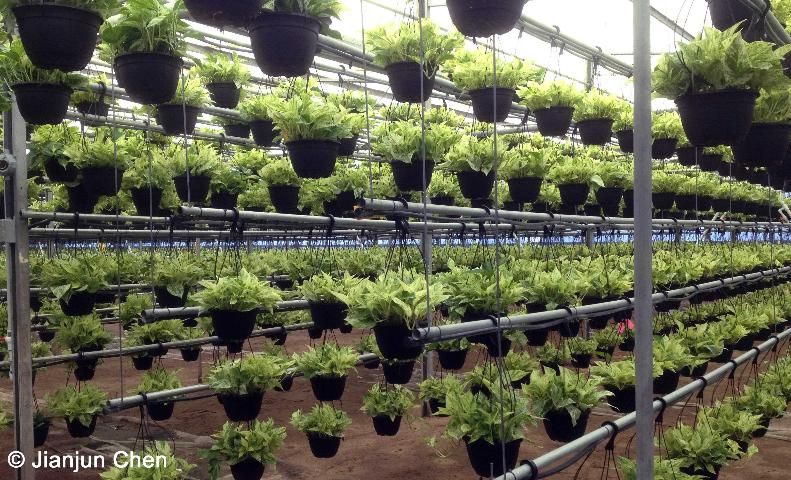Epipremnum, a genus in the family Araceae, derives its name from a combination of two Greek words: epi meaning "on" and premnon meaning "trunk." This describes the genus and its 10 known species as tree-climbing vines. The only species commercially produced and used as an interiorscape plant is E. aureum, commonly called pothos or devil's ivy. This native of the Solomon Islands is one of the most common interiorscape plants. Millions of these plants have been grown and sold for use indoors during the last 80 years. Surprisingly, it was not until the 1960s that taxonomists finally decided this foliage favorite was a species in the Epipremnum genus. This plant had been previously classified as Pothos aureus, Scindapsus aureus, and Raphidophora aurea. What was the reason for all these name changes? Even in its native habitat pothos seldom flowers, and correct taxonomic classification was only possible when enough flowers were collected in Florida and Puerto Rico for detailed examination. In tropical settings pothos can grow to be large vines, climbing trees 50 feet tall and producing lobed, fenestrate leaves up to three feet in length. Plants used for interiorscapes have heart-shaped leaves that seldom exceed six inches in length. Their growth habit makes all these cultivars useful as totems, hanging baskets, ground covers, pedestal plants, dish gardens, and small desk plants. This article describes common Epipremnum species and cultivars in the foliage plant industry (See Table 1), provides guidelines on their culture and interior use, and lists physiological problems encountered in both production and in the interiorscape (See Table 3).

Credit: Jianjun Chen, UF/IFAS
Cultural Guidelines
Propagation
The most common method used to propagate pothos is to make one to 1½-inch stem cuttings with a node and an attached leaf. Buds break in 2–3 weeks and rooting occurs in 3–4 weeks. If larger leafed cuttings are desired for totems, stock plants are grown on a pole or similar support and tip cuttings are used.
Production
Sphagnum peat, pine bark, vermiculite, or perlite can be volumetrically combined to formulate media for most container sizes. Three-foot and taller totems should have 10-20% coarse sand to keep plants from wind tipping. Media should have good moisture-holding capacity and aeration, soluble salts of 3–5 dS/m, and pH of 6.5 to 7.0.
Pothos should be grown in a shadehouse with temperature between 70 to 90°F and a relative humidity of 60 to 100%. Plant quality and growth rates begin to decline when day temperatures routinely exceed 95°F or night temperatures drop below 65°F. Controlled-release or water-soluble fertilizers, or a combination of both, can be used for pothos production. Use a fertilizer with an N:P:K ratio of 3:1:2 or 3:1:3. The suggested application rate is 5 lb N per 1,000 sq. ft per month. Table 2 provides a guide for determining if pothos are appropriately fertilized based on leaf analysis.
Pothos should be grown with levels of 63 to 80% shade (3250 to 2500 ft-c). Growth rate and color in the variegated cultivars decrease when shade levels are greater than 80% (2500 ft-c).
Shipping and Interior care
Pothos should be shipped at temperatures between 55°F and 65°F. Once plants are placed indoors, it is advisable not to re-pot or fertilize for about four weeks because plants do not need additional stresses. Plants should not be fertilized if soluble salts are 3.0 dS/m or more. If soluble salt levels are higher than 5.0 dS/m, percolation of media with water may help reduce potential leaf necrosis or damage to the root system. Media should be kept moist. In most interior locations pothos does better if grown "a little on the dry side." They will tolerate light levels as low as 50 fc but new leaves will be small and variegated cultivars will lose color. Light levels of 150 fc or more will maintain color and leaf size. Temperatures of 70°F to 80°F are recommended.